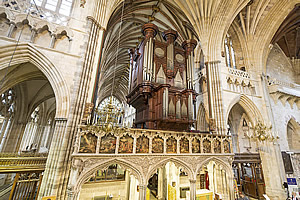Six centuries of Organ building in Devon
Nigel Browne
Published by At the sign of the Pipe, £25 plus £3.50 p&p.
Available through: www.signofthepipe.com

This paperback book is a well researched history of the organs built in Devon during more than six centuries from the late 13th century/early 14th to the end of the First World War in the 20th. It is based on extensive studies of documentary sources and descriptions of surviving instruments, and draws on Dr. Browne’s PhD thesis of organs, organ-builders and organists in 19th century Devon at the University of Exeter.
After a brief introduction the contents are divided into five parts, part I commencing with the mention of an organ case in Exeter cathedral in the late 13th century, followed by one of the earliest known references to an organ in a parish church in 1307, and continuing with the increase in activity in the county during the 15th and 16th centuries followed by antipathy and volatility culminating in the Commonwealth. The chapter also includes details of the work of other known organ builders including John and his son William Gye, Laurence Playssher who installed an organ in Exeter cathedral in 1514, John Paunchard and the extended Chappington family of North Devon from 1536 onwards, the organ installed in Braunton in 1570 being the last known in the 16th century from surviving documents, with very few organs indeed built in the county in the 17th century. A detailed account is provided of the best known Devonian builder of the time, John Loosemore, born in 1616, generally more active in repairs and tuning until the building of the post restoration organ in Exeter cathedral in 1662, which is fully described. The chapter concludes at the time of the death of Charles Rewallin in 1697.
Part II looks at organ building in Tiverton from 1696, when the first new organ in the diocese outside Exeter was opened, built by Christian Smith, nephew of Father Bernard Smith, and at further new organs built and installed in the county during the early 18th century, discussing the instrurments made by James Parsons of Plymouth, John Crang, whose claviorgan is at Edinburgh University, and the more substantial output of Paul Micheau in the late 18th century until his retirement in 1817, followed by the work of Henry Leaman in Exeter up to 1814. Part III, by far the longest, covers the increasing establishment of workshops in Exeter from 1815 to 1914 as more and more instruments were being built and installed in churches, with the main attention being focussed on the many organs built by Henry Philip Dicker, whose working life is covered in four sections. Some further 18 builders are mentioned and their instruments discussed, among the more active we find Henry Crabb of Exeter, James Philpott of Exeter, William Henry Cox Hawker who worked in Exeter after moving from Farrington.
Part IV covers organ builders in the early 19th century onwards working in Plymouth, Newton Abbot and elsewhere in the county, including some 17 builders, some being born outside the county and either moving into it or working in it, some of whom produced only one documented organ, and the starting up and ongoing production of Hele and Company, still surviving today. A few of the more active builders include George Tucker originally from Bristol area, George Hawkins of Newton Abbot and John Mortimore from Bradninch. Part V includes seven organ builders of the 18th and 19th century with Devonian connections but who worked primarily outside of the county, including Jonas Ley, James and John Crang Hancock, Alexander Buckingham, William Giles, John Squire, Charles Martin and William Martin Hedgeland.
There are 29 illustrations in the body of the book, along with many specifications of organs described, giving us a developing snapshot of changes in fashion, and at the end there are six colour plates, an appendix lists a summary of new and rebuilt organs by Henry Philip Dicker from 1839-91, an addenda gives updated information about other organs built by George Dennis and about instruments by William and Thomas Robjohn which became available after the text of the book was completed, a short bibliography gives further reading and there is a comprehensive index of people and places to enable quick reference. Fortunately there are plenty of footnotes rather than chapter endnotes, which saves the reader much time. There are many specifications throughout the book, and many quotes from contemporary documents adding invaluable local comments. This is a well written and very readable guide to organ building in a large county with only three large centres of population and well distant from London, and much of the information, especially pertaining to the activity of earlier centuries, will surprise and perhaps encourage visits to those churches in which historic instruments still remain. Many of the names mentioned and whose instruments were described and evaluated will almost certainly be new to the great majority of readers; a number of them were also active outside the county. One problem encountered with the binding is the difficulty of keeping a double page spread open. The book will be of great interest not only to those researching organ history in the UK but also to local historians and those interested in Devon generally, and is very highly recommended; perhaps Dr. Browne will publish a subsequent volume or add an extra chapter in a reprint of the ongoing work by builders and tuners in the 20th century through to the present day.
John Collins
